Li Xiao
Impact of Phonetics on Speaker Identity in Adversarial Voice Attack
Sep 18, 2025Abstract:Adversarial perturbations in speech pose a serious threat to automatic speech recognition (ASR) and speaker verification by introducing subtle waveform modifications that remain imperceptible to humans but can significantly alter system outputs. While targeted attacks on end-to-end ASR models have been widely studied, the phonetic basis of these perturbations and their effect on speaker identity remain underexplored. In this work, we analyze adversarial audio at the phonetic level and show that perturbations exploit systematic confusions such as vowel centralization and consonant substitutions. These distortions not only mislead transcription but also degrade phonetic cues critical for speaker verification, leading to identity drift. Using DeepSpeech as our ASR target, we generate targeted adversarial examples and evaluate their impact on speaker embeddings across genuine and impostor samples. Results across 16 phonetically diverse target phrases demonstrate that adversarial audio induces both transcription errors and identity drift, highlighting the need for phonetic-aware defenses to ensure the robustness of ASR and speaker recognition systems.
PepThink-R1: LLM for Interpretable Cyclic Peptide Optimization with CoT SFT and Reinforcement Learning
Aug 20, 2025



Abstract:Designing therapeutic peptides with tailored properties is hindered by the vastness of sequence space, limited experimental data, and poor interpretability of current generative models. To address these challenges, we introduce PepThink-R1, a generative framework that integrates large language models (LLMs) with chain-of-thought (CoT) supervised fine-tuning and reinforcement learning (RL). Unlike prior approaches, PepThink-R1 explicitly reasons about monomer-level modifications during sequence generation, enabling interpretable design choices while optimizing for multiple pharmacological properties. Guided by a tailored reward function balancing chemical validity and property improvements, the model autonomously explores diverse sequence variants. We demonstrate that PepThink-R1 generates cyclic peptides with significantly enhanced lipophilicity, stability, and exposure, outperforming existing general LLMs (e.g., GPT-5) and domain-specific baseline in both optimization success and interpretability. To our knowledge, this is the first LLM-based peptide design framework that combines explicit reasoning with RL-driven property control, marking a step toward reliable and transparent peptide optimization for therapeutic discovery.
Human-Aligned Bench: Fine-Grained Assessment of Reasoning Ability in MLLMs vs. Humans
May 16, 2025Abstract:The goal of achieving Artificial General Intelligence (AGI) is to imitate humans and surpass them. Models such as OpenAI's o1, o3, and DeepSeek's R1 have demonstrated that large language models (LLMs) with human-like reasoning capabilities exhibit exceptional performance and are being gradually integrated into multimodal large language models (MLLMs). However, whether these models possess capabilities comparable to humans in handling reasoning tasks remains unclear at present. In this paper, we propose Human-Aligned Bench, a benchmark for fine-grained alignment of multimodal reasoning with human performance. Specifically, we collected 9,794 multimodal questions that solely rely on contextual reasoning, including bilingual (Chinese and English) multimodal questions and pure text-based questions, encompassing four question types: visual reasoning, definition judgment, analogical reasoning, and logical judgment. More importantly, each question is accompanied by human success rates and options that humans are prone to choosing incorrectly. Extensive experiments on the Human-Aligned Bench reveal notable differences between the performance of current MLLMs in multimodal reasoning and human performance. The findings on our benchmark provide insights into the development of the next-generation models.
Learning 3D Medical Image Models From Brain Functional Connectivity Network Supervision For Mental Disorder Diagnosis
Mar 06, 2025



Abstract:In MRI-based mental disorder diagnosis, most previous studies focus on functional connectivity network (FCN) derived from functional MRI (fMRI). However, the small size of annotated fMRI datasets restricts its wide application. Meanwhile, structural MRIs (sMRIs), such as 3D T1-weighted (T1w) MRI, which are commonly used and readily accessible in clinical settings, are often overlooked. To integrate the complementary information from both function and structure for improved diagnostic accuracy, we propose CINP (Contrastive Image-Network Pre-training), a framework that employs contrastive learning between sMRI and FCN. During pre-training, we incorporate masked image modeling and network-image matching to enhance visual representation learning and modality alignment. Since the CINP facilitates knowledge transfer from FCN to sMRI, we introduce network prompting. It utilizes only sMRI from suspected patients and a small amount of FCNs from different patient classes for diagnosing mental disorders, which is practical in real-world clinical scenario. The competitive performance on three mental disorder diagnosis tasks demonstrate the effectiveness of the CINP in integrating multimodal MRI information, as well as the potential of incorporating sMRI into clinical diagnosis using network prompting.
A Scalable Crawling Algorithm Utilizing Noisy Change-Indicating Signals
Feb 04, 2025Abstract:Web refresh crawling is the problem of keeping a cache of web pages fresh, that is, having the most recent copy available when a page is requested, given a limited bandwidth available to the crawler. Under the assumption that the change and request events, resp., to each web page follow independent Poisson processes, the optimal scheduling policy was derived by Azar et al. 2018. In this paper, we study an extension of this problem where side information indicating content changes, such as various types of web pings, for example, signals from sitemaps, content delivery networks, etc., is available. Incorporating such side information into the crawling policy is challenging, because (i) the signals can be noisy with false positive events and with missing change events; and (ii) the crawler should achieve a fair performance over web pages regardless of the quality of the side information, which might differ from web page to web page. We propose a scalable crawling algorithm which (i) uses the noisy side information in an optimal way under mild assumptions; (ii) can be deployed without heavy centralized computation; (iii) is able to crawl web pages at a constant total rate without spikes in the total bandwidth usage over any time interval, and automatically adapt to the new optimal solution when the total bandwidth changes without centralized computation. Experiments clearly demonstrate the versatility of our approach.
FreeCodec: A disentangled neural speech codec with fewer tokens
Dec 02, 2024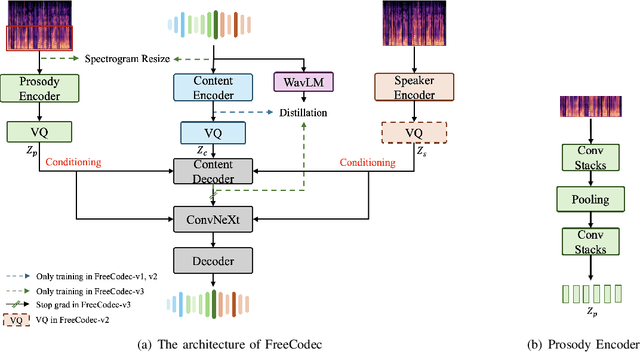
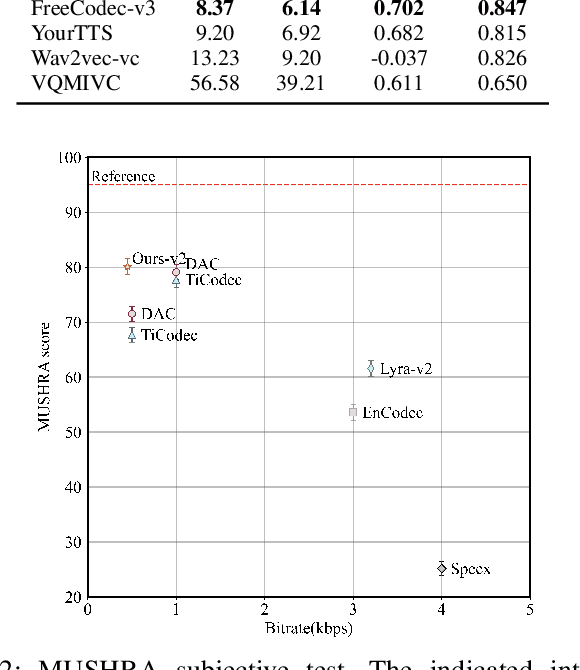

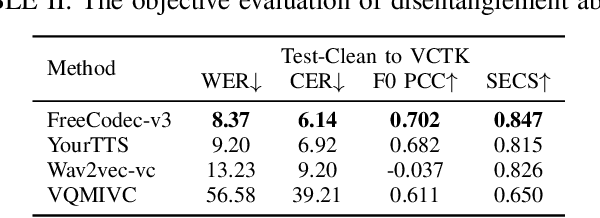
Abstract:Neural speech codecs have gained great attention for their outstanding reconstruction with discrete token representations. It is a crucial component in generative tasks such as speech coding and large language models (LLM). However, most works based on residual vector quantization perform worse with fewer tokens due to low coding efficiency for modeling complex coupled information. In this paper, we propose a neural speech codec named FreeCodec which employs a more effective encoding framework by decomposing intrinsic properties of speech into different components: 1) a global vector is extracted as the timbre information, 2) a prosody encoder with a long stride level is used to model the prosody information, 3) the content information is from a content encoder. Using different training strategies, FreeCodec achieves state-of-the-art performance in reconstruction and disentanglement scenarios. Results from subjective and objective experiments demonstrate that our framework outperforms existing methods.
Advancing Fine-Grained Visual Understanding with Multi-Scale Alignment in Multi-Modal Models
Nov 14, 2024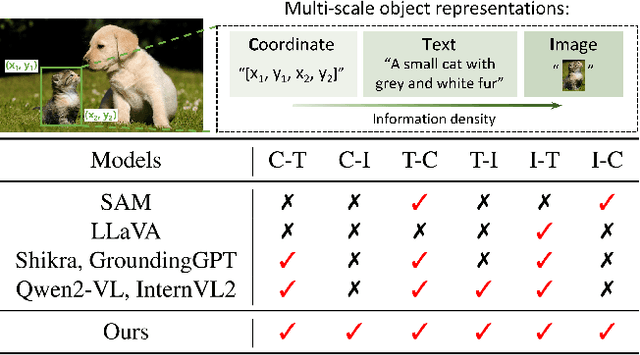
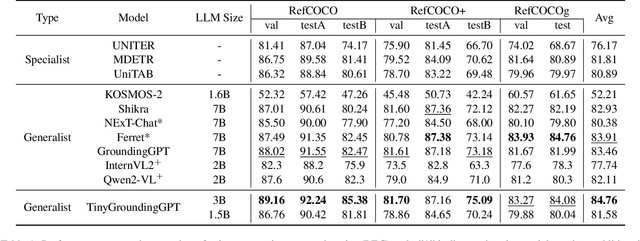
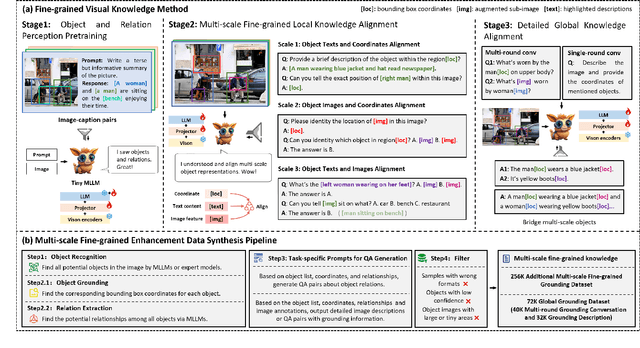
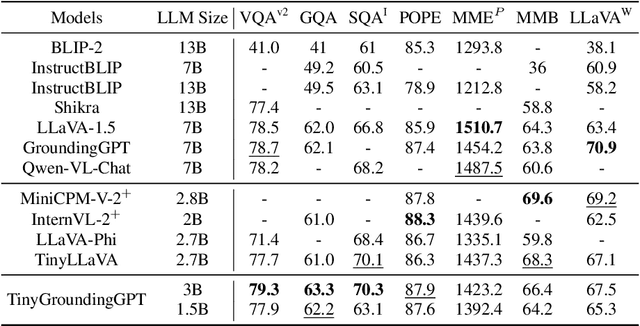
Abstract:Multi-modal large language models (MLLMs) have achieved remarkable success in fine-grained visual understanding across a range of tasks. However, they often encounter significant challenges due to inadequate alignment for fine-grained knowledge, which restricts their ability to accurately capture local details and attain a comprehensive global perception. While recent advancements have focused on aligning object expressions with grounding information, they typically lack explicit integration of object images, which contain affluent information beyond mere texts or coordinates. To bridge this gap, we introduce a novel fine-grained visual knowledge alignment method that effectively aligns and integrates multi-scale knowledge of objects, including texts, coordinates, and images. This innovative method is underpinned by our multi-scale fine-grained enhancement data synthesis pipeline, which provides over 300K essential training data to enhance alignment and improve overall performance. Furthermore, we present TinyGroundingGPT, a series of compact models optimized for high-level alignments. With a scale of approximately 3B parameters, TinyGroundingGPT achieves outstanding results in grounding tasks while delivering performance comparable to larger MLLMs in complex visual scenarios.
SuperCodec: A Neural Speech Codec with Selective Back-Projection Network
Jul 30, 2024



Abstract:Neural speech coding is a rapidly developing topic, where state-of-the-art approaches now exhibit superior compression performance than conventional methods. Despite significant progress, existing methods still have limitations in preserving and reconstructing fine details for optimal reconstruction, especially at low bitrates. In this study, we introduce SuperCodec, a neural speech codec that achieves state-of-the-art performance at low bitrates. It employs a novel back projection method with selective feature fusion for augmented representation. Specifically, we propose to use Selective Up-sampling Back Projection (SUBP) and Selective Down-sampling Back Projection (SDBP) modules to replace the standard up- and down-sampling layers at the encoder and decoder, respectively. Experimental results show that our method outperforms the existing neural speech codecs operating at various bitrates. Specifically, our proposed method can achieve higher quality reconstructed speech at 1 kbps than Lyra V2 at 3.2 kbps and Encodec at 6 kbps.
SimuSOE: A Simulated Snoring Dataset for Obstructive Sleep Apnea-Hypopnea Syndrome Evaluation during Wakefulness
Jul 10, 2024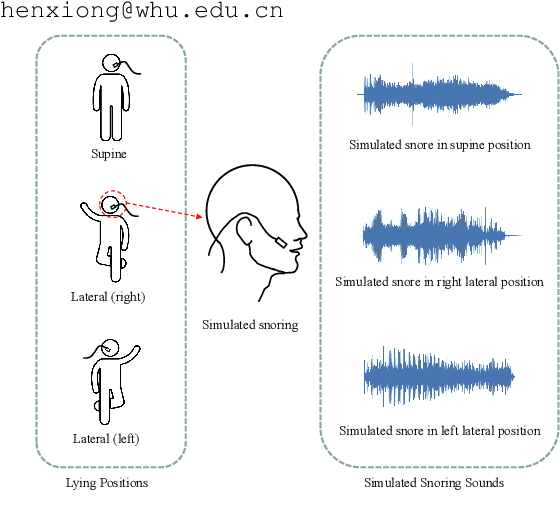

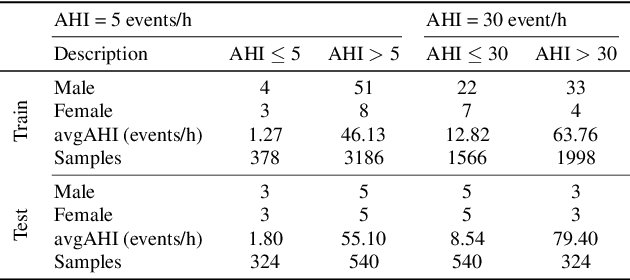

Abstract:Obstructive Sleep Apnea-Hypopnea Syndrome (OSAHS) is a prevalent chronic breathing disorder caused by upper airway obstruction. Previous studies advanced OSAHS evaluation through machine learning-based systems trained on sleep snoring or speech signal datasets. However, constructing datasets for training a precise and rapid OSAHS evaluation system poses a challenge, since 1) it is time-consuming to collect sleep snores and 2) the speech signal is limited in reflecting upper airway obstruction. In this paper, we propose a new snoring dataset for OSAHS evaluation, named SimuSOE, in which a novel and time-effective snoring collection method is introduced for tackling the above problems. In particular, we adopt simulated snoring which is a type of snore intentionally emitted by patients to replace natural snoring. Experimental results indicate that the simulated snoring signal during wakefulness can serve as an effective feature in OSAHS preliminary screening.
Aligning in a Compact Space: Contrastive Knowledge Distillation between Heterogeneous Architectures
May 28, 2024



Abstract:Knowledge distillation is commonly employed to compress neural networks, reducing the inference costs and memory footprint. In the scenario of homogenous architecture, feature-based methods have been widely validated for their effectiveness. However, in scenarios where the teacher and student models are of heterogeneous architectures, the inherent differences in feature representation significantly degrade the performance of these methods. Recent studies have highlighted that low-frequency components constitute the majority of image features. Motivated by this, we propose a Low-Frequency Components-based Contrastive Knowledge Distillation (LFCC) framework that significantly enhances the performance of feature-based distillation between heterogeneous architectures. Specifically, we designe a set of multi-scale low-pass filters to extract the low-frequency components of intermediate features from both the teacher and student models, aligning them in a compact space to overcome architectural disparities. Moreover, leveraging the intrinsic pairing characteristic of the teacher-student framework, we design an innovative sample-level contrastive learning framework that adeptly restructures the constraints of within-sample feature similarity and between-sample feature divergence into a contrastive learning task. This strategy enables the student model to capitalize on intra-sample feature congruence while simultaneously enhancing the discrimination of features among disparate samples. Consequently, our LFCC framework accurately captures the commonalities in feature representation across heterogeneous architectures. Extensive evaluations and empirical analyses across three architectures (CNNs, Transformers, and MLPs) demonstrate that LFCC achieves superior performance on the challenging benchmarks of ImageNet-1K and CIFAR-100. All codes will be publicly available.
 Add to Chrome
Add to Chrome Add to Firefox
Add to Firefox Add to Edge
Add to Edge